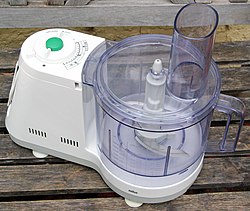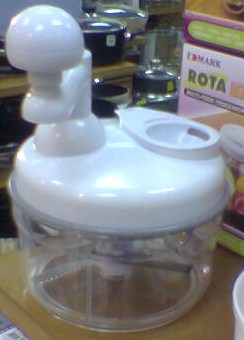| Revision as of 04:25, 31 January 2017 edit109.64.127.29 (talk) →FunctionsTag: wikilinks removed← Previous edit | Revision as of 06:18, 31 January 2017 edit undoBallenaBlanca (talk | contribs)Extended confirmed users6,901 edits Reverted edits by 109.64.127.29 (talk) Spamming multiple pages - https://anytimemagazine.comNext edit → | ||
| Line 14: | Line 14: | ||
| ==Functions== | ==Functions== | ||
| Food processors normally have multiple functions, depending on the placement and type of attachment or blade. These functions normally include: | |||
| * ]/] ]s | * ]/] ]s | ||
| * Grinding items such as nuts, seeds (e.g. spices), meat, or ] | * Grinding items such as nuts, seeds (e.g. spices), meat, or ] | ||
Revision as of 06:18, 31 January 2017
| This article needs additional citations for verification. Please help improve this article by adding citations to reliable sources. Unsourced material may be challenged and removed. Find sources: "Food processor" – news · newspapers · books · scholar · JSTOR (October 2012) (Learn how and when to remove this message) |


A food processor is a kitchen appliance used to facilitate repetitive tasks in the preparation of food. Today, the term almost always refers to an electric-motor-driven appliance, although there are some manual devices also referred to as "food processors".
Food processors are similar to blenders in many forms. The primary difference is that food processors use interchangeable blades and disks (attachments) rather than a fixed blade. Also, their bowls are wider and shorter, a more proper shape for the solid or semi-solid foods usually worked in a food processor. Usually, little or no liquid is required in the operation of the food processor, unlike a blender, which requires a certain amount of liquid for the particles to move around the blade.
History
One of the first electric food processors was the Starmix, introduced by German company Electrostar in 1946. Although the basic unit resembled a simple blender, numerous accessories were available, including attachments for slicing bread, milk centrifuges and ice cream bowls. In a time when electric motors were expensive, they also developed the piccolo, where the food processor's base unit could drive a vacuum cleaner. In the 1960s, Albrecht von Goertz designed the Starmix MX3 food processor. Although the entire company was rebranded as Starmix in 1968 following the success of the processors, they later focused on vacuum cleaners and electric hand-dryers and the last mixer was produced around the year 2000. In France, the concept of a machine to process food began when a catering company salesman, Pierre Verdun, observed the large amount of time his clients spent in the kitchen chopping, shredding and mixing. He produced a simple but effective solution, a bowl with a revolving blade in the base. In 1960, this evolved into Robot-Coupe, a company established to manufacture commercial "food processors" for the catering industry. In the late 1960s, a commercial food processor driven by a powerful commercial induction motor was produced. The Magimix food processor arrived from France in the UK in 1974, beginning with the Model 1800. Then, a UK company Kenwood Limited started their own first Kenwood Food Processor, 'processor de- luxe,' in 1979.
Carl Sontheimer introduced this same Magimix 1800 food processor to North America in 1973 under the Cuisinart brand, as America's first domestic food processor. Sontheimer contracted with a Japanese manufacturer to produce new models in 1977 in order to immediately launch his new Japanese-made food processor in 1980 when his contract with Robot-Coupe expired.
Functions
Food processors normally have multiple functions, depending on the placement and type of attachment or blade. These functions normally include:
- Slicing/chopping vegetables
- Grinding items such as nuts, seeds (e.g. spices), meat, or dried fruit
- Shredding or grating cheese or vegetables
- Pureeing
- Mixing and kneading doughs
Design and operation
The base of the unit houses a motor which turns a vertical shaft. A bowl, usually made of transparent plastic, fits around the shaft. Cutting blades can be attached to the shaft; these fit so as to operate near the bottom of the bowl. Shredding or slicing disks can be attached instead; these spin near the top of the bowl. A lid with a "feed tube" is then fitted onto the bowl.
The feed tube allows ingredients to be added while chopping, grinding or pureeing. It also serves as a chute through which items are introduced to shredding or slicing disks. A "pusher" is provided, sized to slide through the feed tube, protecting the user's fingers.
Almost all modern food processors have safety devices which prevent the motor from operating if the bowl is not properly secured to the base or if the lid is not properly secured to the bowl.
See also
- Blade grinder
- Blender
- Bread machine
- Coffee grinder
- Electric pressure cooking
- Food processing
- Ultrasonic homogenizer
- Grater, a non-electric kitchen cutting implement
- Home robot
- Mandoline, a kitchen cutting device that uses similar styles of blades to some food processors
- Multicooker
References
- "Die Jahre 1945 - 1960". Robert-schoettle.net. Retrieved 2012-10-14.
- Electrostar Gmbh. "Sauger, Händetrockner und Industriesauger von Starmix, auch Haartrockner und Nass-Trockensauger". Starmix.de. Retrieved 2012-10-14.
- Martin Weck. "Starmix von Electrostar um 1960". Eichwaelder.de. Retrieved 2012-10-14.
- "Starmix - Werbung". YouTube. 2009-04-29. Retrieved 2012-10-14.
- "Das Buch vom Starmix: Amazon.de: Bücher". Amazon.de. Retrieved 2012-10-14.
- "Der 007 des Designs - NZZ.ch, 23.02.2011". Nzz.ch. Retrieved 2012-10-14.
- "Albrecht Graf Goertz: Eigensinn und Stilgefühl - SPIEGEL ONLINE - Auto". Spiegel.de. 2011-01-22. Retrieved 2012-10-14.
- Anonymous. "About Kenwood Limited". Kenwood. Retrieved 2012-07-10.